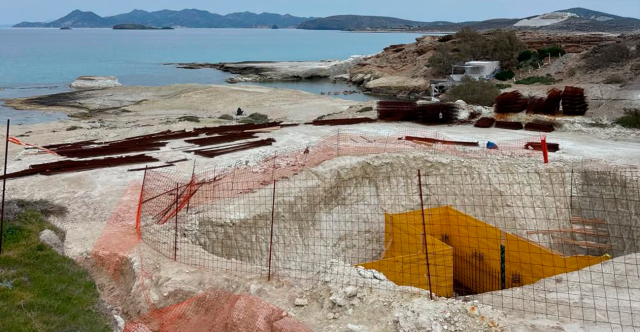Opulent underground monument in northern Greece was for Hephaestion, closest friend and general of Alexander the Great, archaeologist claims
Greeks have been enthralled for years by the mystery surrounding the Amphipolis monument.
Katerina Peristeri has revealed that fragmentary inscriptions link the tomb to Hephaestion.
Hephaestion died less than a year before the Macedonian leader.
After his death in 325BC, Alexander was said to have ordered that shrines be constructed throughout the empire.
Monogram
Ms Peristeri's team believe the site at Amphipolis may have been designed by one of two architects, Dinocrates or Stesicrates, and built by Antigonus, another of Alexander's generals.
They also believe that tiny inscriptions found at the site show Hephaestion's monogram (two initials from his name).
However, not everyone was convinced by the team's revelations.
Prof Panayiotis Faklaris of Aristotle University of Thessaloniki told there was no indication that the tomb had any connection to Hephaestion or that Alexander had ordered it to be constructed.
There had earlier been speculation that the tomb may be linked to Alexander the Great's mother Olympias or his wife Roxana.
Bones of a woman believed to be over 60 years of age found at the Kastas hill in Amphipolis
And earlier this year bones were recovered at the site that belonged to at least five individuals, including an elderly woman, a newborn child and two men, one of whom had been stabbed.
As well as 550 fragments of bone, animal as well as human, archaeologists have uncovered three vaulted chambers behind a facade decorated with two big marble sphinxes.
Within the chambers were a pair of caryatids - larger-than-life statues of young women - and a mosaic pavement depicting the abduction of the goddess Persephone by Hades, king of the underworld.
The partially unearthed entrance to the Kasta Tumulus in ancient Amphipolis Photo: AFP/Getty Images
The tomb also contained a mosaic floor representing the ancient Greek god of the underworld, Pluto, abducting the goddess Persephone on a horse-drawn chariot as the god Hermes looks on Photo: AP
Alexander, who built an empire from modern Greece to India, was buried in Egypt although the precise location remains a mystery.
As his generals fought over his legacy, his mother, widow, son and half brother were all killed, most of them near Amphipolis.
A sketch of the tomb
Amphipolis site
437 BC: Founded by Athenians near gold and silver mines of Pangaion hills
357 BC: Conquered by Philip II of Macedon, Alexander the Great's father
Under Alexander, served as major naval base, from which fleet sailed for Asia
1964: First official excavation began, led by Dimitris Lazaridis
A protective shelter excavators built over the entrance - decorated with headless marble sphinxes to a large 4th century B.C. tomb under excavation at Amphipolis in northern Greece Photo: Greek Ministry of Culture
Alexander led an army of Greeks to conquer a vast empire stretching as far as modern Pakistan. Ancient writers say he considered Hephaestion to be his alter ego, making him the second most powerful man in the empire.
When Hephaestion died, Alexander is recorded to have granted him hero's rites, declared mourning throughout the empire and had him cremated in Babylon at enormous expense.














